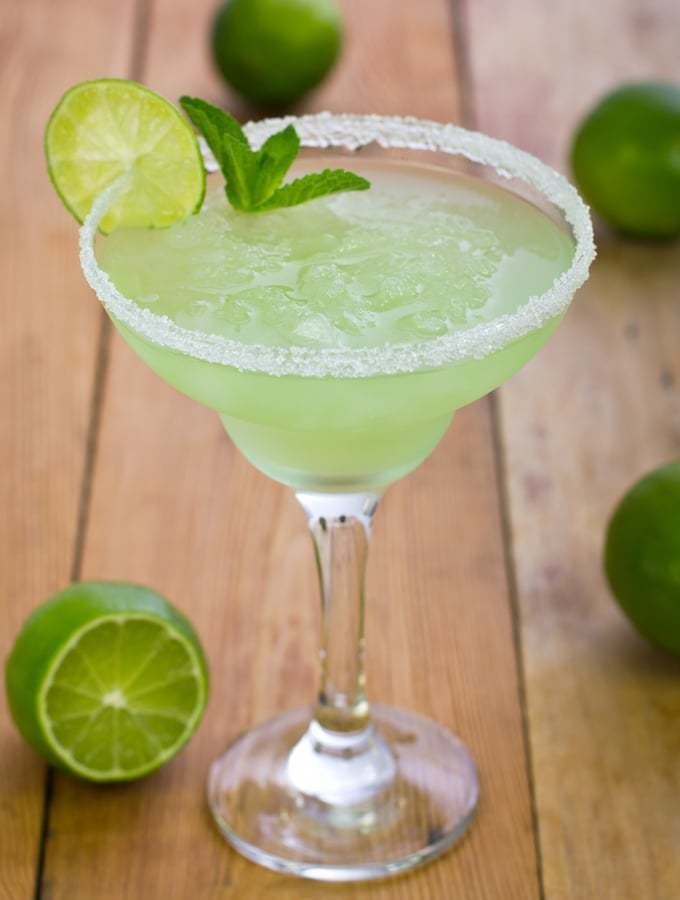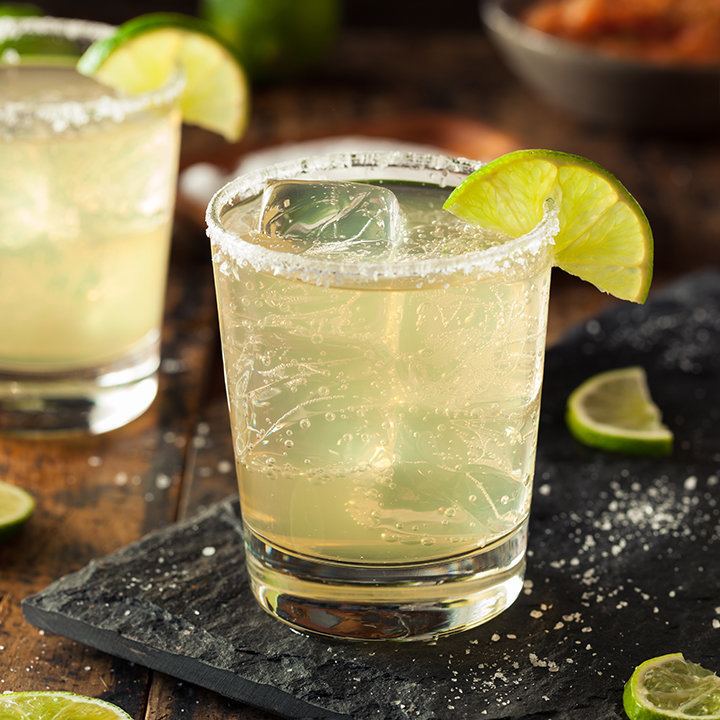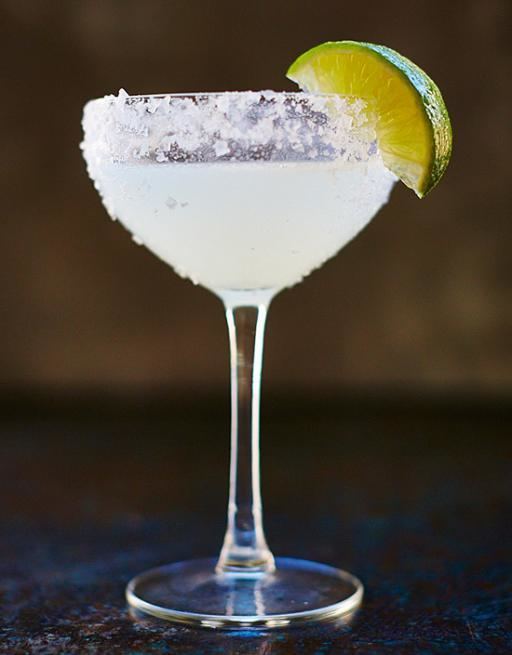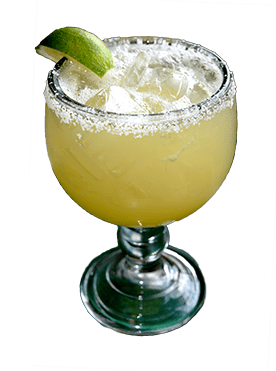Drinkware Margarita glass | ||
 | ||
Preparation Rub the rim of the glass with the lime slice to make the salt stick to it. Shake the other ingredients with ice, then carefully pour into the glass (taking care not to dislodge any salt). Garnish and serve over ice. Served On the rocks; poured over ice Standard garnish Lime slice, Salt on the rim Similar Mojito, Martini, Tequila, Daiquiri, Triple sec | ||
How to make a margarita cocktail recipes
A margarita is a cocktail consisting of triple sec, tequila and lime or lemon juice, often served with salt or sugar on the rim of the glass. The drink is served shaken with ice (on the rocks), blended with ice (frozen margarita), or without ice (straight up). Although it has become acceptable to serve a margarita in a wide variety of glass types, ranging from cocktail and wine glasses to pint glasses and even large schooners, the drink is traditionally served in the eponymous margarita glass, a stepped-diameter variant of a cocktail glass or champagne coupe.
Contents
- How to make a margarita cocktail recipes
- Margarita cocktail drink recipe
- Variations
- Flavored liqueurs
- Fresh lime juice
- Frozen margarita
- Other fruits
- Coronarita
- Origin
- Glass
- Popularity
- References

Margarita cocktail drink recipe
Variations

The IBA (IBA Official list of Cocktails) standard is 7:4:3, that is, 50% tequila, 29% Cointreau, 21% fresh lime juice.

The "Original Margarita" recipe as given by Cointreau on their website has less of their own sweet liquor: 1 part white tequila, 1/2 part Cointreau, and 1/2 part fresh squeezed lime juice.
Flavored liqueurs
Besides Cointreau, other orange-flavored liqueurs that might be used include Grand Marnier, Gran Gala, other brands of triple sec, or blue curaçao (yielding the blue margarita). When sweeter fruit juices or freshly puréed fruits are added to the margarita, the orange-flavored liqueur is often reduced or eliminated entirely. In addition to orange-flavored liqueurs, secondary liqueurs may occasionally be added to a cocktail, including melon-flavored or black raspberry-flavored. Other flavors include pineapple and watermelon.
Fresh lime juice
Freshly squeezed lime juice is the key ingredient. The most common lime in the United States is the thick-skinned Persian lime. However, margaritas in Mexico are generally made with Mexican limes (Key limes). These are small, thin-skinned limes and have more tart and an often bitter flavor compared to Persian limes.
Frozen margarita

In addition to being shaken and served "up" like other cocktails, margaritas can also be served as a blended ice slush similar to other tropical-inspired mixed drinks like the hurricane or piña colada. This variant is known as a frozen margarita. The ingredients can be poured over crushed ice in a kitchen blender, or for larger establishments that serve many of these, a large quantity of a "house recipe" of frozen margarita can be kept in a machine designed specifically for the purpose (but also commonly used to serve non-alcoholic slush drinks); a cylinder leading to a pour spout is kept below freezing temperature, but an impeller within the cylinder constantly churns the mix so it can't freeze solid, and so it dispenses as a thick half-frozen slush. The first frozen margarita machine was invented on May 11, 1971 by Dallas restaurateur Mariano Martinez. The machine was originally a soft-serve ice cream machine and now sits in the Smithsonian National Museum of History.
Other fruits

Alternate fruits and juice mixtures can also be used in a margarita. Fruits like mango, peach, strawberry, banana, melon, or raspberry are suitable for creating this drink. Many recipes call for a splash of orange juice. These days, margarita can be prepared in many different ways. When the word "margarita" is used by itself, it typically refers to the lime or lemon juice margarita, but when other juices are used, the fruits are typically added as adjectives in the name; with lime juice or lemon juice added to give it a characteristic margarita flavor (a wedge of lime is often added to the glass). Other varieties of margarita include fruit margarita, top-shelf margarita and virgin margarita.
Coronarita
Some bars and restaurants serve a "Coronarita", beer cocktail that consists of a bottle of Corona upturned to drain into a margarita.
Origin
The 1937 Cafe Royal Cocktail Book contains a recipe for a Picador using the same concentrations of tequila, triple sec and lime juice as a Margarita. One of the earliest stories is of the Margarita being invented in 1938 by Carlos "Danny" Herrera at his restaurant Rancho La Gloria, halfway between Tijuana and Rosarito, Mexico, created for customer and former Ziegfeld dancer Marjorie King, who was allergic to many spirits, but not to tequila. This story was related by Herrera and also by bartender Albert Hernandez, acknowledged for popularizing a Margarita in San Diego after 1947, at the La Plaza restaurant in La Jolla. Hernandez claimed the owner of La Plaza, Morris Locke, knew Herrera and visited Mexico often.
A commonly accepted origin story of the Margarita is that it was invented in October 1941, at Hussong's Cantina in Ensenada, Mexico, by bartender Don Carlos Orozco. One afternoon, Margarita Henkel, the daughter of the then German ambassador visited the cantina and Don Carlos who had been experimenting with drinks offered her one. The cocktail consisted of equal parts of tequila, Mexican orange liqueur called Controy (A.K.A. Naranja in the United States), and lime, shaken and served over ice in a salt-rimmed glass. As she was the first to try the drink, Don Carlos decided to name it after her and the "Margarita" was born.
There are also claims that the margarita was first mixed in Juárez, Mexico at Tommy's Place Bar on July 4, 1942 by Francisco "Pancho" Morales. Morales later left bartending in Mexico to become a US citizen, where he worked as a milkman for 25 years. Mexico's official news agency Notimex and many experts have said Morales has the strongest claim to having invented the margarita.
Others say the inventor was Dallas socialite Margarita Sames, when she concocted the drink for her guests at her Acapulco vacation home in 1948. Tommy Hilton reportedly attended, bringing the drink back to the Hilton chain of hotels. However, Jose Cuervo was already running ad campaigns for the margarita three years earlier, in 1945, with the slogan, "Margarita: It's more than a girl's name." According to Jose Cuervo, the cocktail was invented in 1938 by a bartender in honor of Mexican showgirl Rita de la Rosa.
Another common origin tale begins the cocktail's history at the legendary Balinese Room in Galveston, Texas where, in 1948, head bartender Santos Cruz created the margarita for singer Peggy (Margaret) Lee. He supposedly named it after the Spanish version of her name, Margarita, and it has been a hit ever since. (Margarita is a German form of the name and was introduced to Mexico with no Hispanic origin.)
The first known publication of a margarita recipe was in the December 1953 issue of Esquire, with a recipe calling for an ounce of tequila, a dash of triple sec and the juice of half a lime or lemon. A recipe for a tequila-based cocktail first appeared in the 1930 book My New Cocktail Book by G.F. Steele. Without noting a specific recipe or inventor, a drink called the Tequila Daisy was mentioned in the Syracuse Herald as early as 1936. Margarita is Spanish for Daisy, which is a nickname for Margaret.
A later story is that the margarita was invented in October 1961, at a party in Houston, Texas, by party goer Robert James "Rusty" Thomson while acting as bartender. He concocted a mixture of equal parts tequila, orange liqueur, lime, and crushed ice in a salt-rimmed glass. However, Thomson's recipe was made with Damiana Liqueur, not Cointreau orange liqueur. It is said that the idea was an experiment after running out of rum while making frozen daiquiris.
Another explanation, however, is that the margarita is merely a popular American drink, the Daisy, remade with tequila instead of brandy, which became popular during Prohibition as people drifted over the border for alcohol. There is an account from 1936 of Iowa newspaper editor James Graham finding such a cocktail in Tijuana, years before any of the other Margarita "creation myths".
Glass
Margaritas may be served in a variety of glasses, most notably the stereotypical margarita glass, a variant of the classic champagne coupe; this is particularly associated with blended fruit margaritas, and the glass is also used for dishes such as guacamole or shrimp cocktails. In formal settings margaritas are often served in a standard cocktail glass, while in informal settings, particularly with ice, margaritas may be served in an old-fashioned glass.
In the U.S., where the frozen drink is popular in Mexican and "Tex-Mex" restaurants, the drink has been seen served in glasses ranging from beer steins to large schooners and even large rounded stemless "fishbowls" (as a large quantity of margarita is typically dispensed this way, the drink is intended to be consumed by multiple patrons, and alcohol-service laws often prohibit a licensed server or bartender from knowingly serving a drink of this size to a single person).
Popularity
The margarita cocktail was the "Drink of the Month" in Esquire magazine, December 1953, pg. 76:
1 ounce tequilaDash of Triple SecJuice of 1/2 lime or lemonPour over crushed ice, stir. Rub the rim of a stem glass with rind of lemon or lime, spin in salt—pour, and sip.It was further popularized by the Jimmy Buffett song "Margaritaville".
